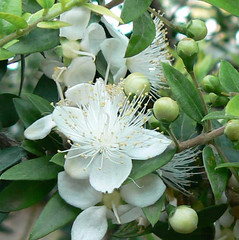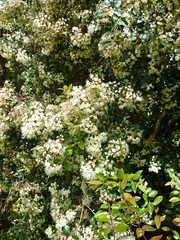Common Myrtle
This Mediterranean shrub has been well known in our gardens since the 16th century. To many cultures it represents 'The Tree of Life' a reflection of its ceremonial use in society.
This began with the Ancient Greeks using the aromatic foliage to crown judges and magistrates as well as ceremonially at the Olympic Games. From these humble origins the cult of myrtle grew to become a plant sacred to the goddess of love (Venus, Aphrodite), it was even reputed to make love grow and sustain it. By the Middle Ages it was deeply embedded in the beliefs surrounding marriage, fertility and erotic love. As such it was often seen in bridal wreaths and head dresses and it is still used by many faiths for this purpose today. Interestingly since the time of Queen Victoria all royal brides in Britain have had a sprig of myrtle in their wedding bouquet.
In milder regions myrtle bushes were also planted to celebrate the birth of a child. Although primarily a love plant, because of its evergreen foliage Virgil saw it as the tree of death containing the souls of those who had died due to a love too passionate. It was also thought to have cleansing powers and as such it was given to the dead at funerals.
The foliage and flowers are the source of a fragrant oil 'Eau d'Ange' used in perfumes and medicines. The timber is used in furniture and the bark in tanning.

